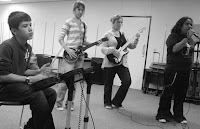 A brief overview
A brief overviewWhat is a podcast and why would I want to make one? A podcast is a syndicated audio broadcast that can be played on any MP3 player (the word comes from combining "iPod" + "broadcast"). When you subscribe to the RSS feed for a podcast, you receive automatic downloads of new content as it is made available online. Podcasts are available on a wide range of topics, just like blogs in audio format. Use Yahoo! Podcasts or Podcast Alley to find podcasts of interest to you. To hear what other teens are doing with podcasts, check out the Teen Podcasters Network or listen to the teen podcasts from Seattle Public Library.
Making your own podcast
Like most any other tools, online podcast tools range from the relatively simple to the more advanced, which often require downloading software. So that this exercise is accessible to everyone, whether or not you have a microphone for your computer, we are going to use a service that allows you to record your podcast through the telephone. Gabcast offers up to one hour of recording for each episode (up to 200 MB of space) with a free account. To get started:
- Create a new account. Enter your personal e-mail address and password and add your avatar, if you choose. You do not need to enter a web site address. You will receive a confirmation e-mail after registering. Just follow the link and begin.
- When you get to your account page, click on "create a channel," then click on "My Channels" to get the number assigned to your channel.
- Call the 800 number listed for the US at the right hand side of the page. You will be asked for you channel number and your password number.
- Record your podcast! You will have the option to listen to your recording or to publish. When you are ready, select publish.
- Return to your online account and select play to listen to your podcast. You can also edit the title and add tags for the episode.
For those of you who would like to explore other podcasting options, take a look at using the Odeo Studio for podcasts or use the podcasting tutorial at Feed for All.
Discovery Exercises
- Follow the steps above to create a Gabcast podcast on any topic of your choice.
- Send us a comment about your podcast.
















